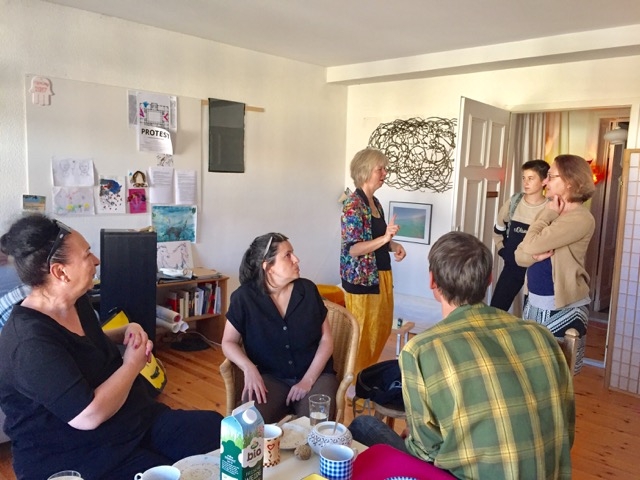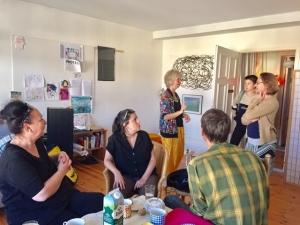Protest – Strategies of Artistic Protest
Protest is always worth it. What is contemporary art worth? Which interests and values are at stake here? The Protest exhibition curated by Lily Fürstenow aims to criticise the contemporary art system by means of elaborating strategies of artistic protest in search of practices that would deal with the existing status quo. The participating artists among which three are from Georgia currently living in Berlin and Tbilisi: Elza Javakhishvili, Theona Paichadze, Tea Nili, Peggy Sylopp, Christine Kühn, Oliver O. Rednitz, Mara Wagenführ, Yair Meshoulam, Grant Simon Rogers, Maj Synje-Berns, Janos Tarko, Allen T. Ball, Barbara von Hartha and Semra Sevin contributed open letters criticising the contemporary art system and artworks expressing their protest. Since the number of artists protesting was too big to be accomodated in one space the exhibition took place in three locations – Pex.Labs artist studio of Peggy Sylopp and at the open studio of recently deceised artist Christine Kühn. The framework discussions accompanying the exhibitions in all three locations have attempted to encourage emancipatory debate rather than focussing on conventional viewing of artworks on show.
Year after year Berlin art scene hypes itself as the magnet for contemporary arts claiming to reflect burning socio-political topics via different artistic positions. In practice however more and more artists are feeling increasingly desperate about what has become of contemporary art scene, because institutional exhibition policies are irrelevant and hardly reflect topics that are at the core of either local societies or international communities in their programs, the choice of artists featured in the exhibitions is made according to highly obscure criteria, because there're instances of artists being censored, unpaid for their work, refused to exhibit, there's a general tendency to show artists that comply with mainstream tastes in order to attract maximum visitors attendance numbers.
Whereas corruption within the art world has become recently a buzzword with quite a number of art experts discussing it on the pages of glossy magazines, little has been done to deal with it or at least to search for ways to resist. In fact, as some art critics might confess, writing about art has lost its former importance, reducing itself to a tool for PR machinery. Common belief among artists holds it that art world is run by globally operating commercial galleries that promote more or less the same artists that are expected to procure high sales, since the material objecthood of artworks turns them into objects of market speculations and lucrative investments. Public institutions, kunsthalles, international art biennales and contemporary art museums follow forth using taxpayers money to promote and feature the same artists thus closing the vicious circle.
One could argue that there's enough room for independent spaces to make visible artistic practices that do not fit into the above-mentioned framework, yet side events and off spaces - posh as they might seem - mostly lack the publicity they deserve because they're poor on quality or are of sporadic character. For artists captured within such conditions it's a matter of enormous personal courage to protest the current status quo. Therefore we're all going to soon find out how much of us and how far we'll be able to take our protest. Anyway there's not much to lose and those who still hesitate, action needs to be taken thus quoting motto of berlin biennale 7 curated by artist Arthur Zmijewsky and his team: Forget Fear!
Of course, contemporary art scene largely depends on networks, friendships, personal tastes of influential curators, jury decisions based on highly obscure sets of criteria and other actors behind the scenes, financial markets inclusive, yet how come that the resulting institutionally exhibited art is so poor on quality and leaves so much to wish for. Protest seems here the only solution, because strategies of artistic protest, which this exhibition seeks to analyse will pave the way to critical and emancipative tendencies in arts.
This exhibition is largely inspired by the history of artistic protest against the so-called establishment – with one of the examples being the Salon des Refusés – in 1863 that included the “R” artists (stamped by the Jury as the Refusés) who were not selected for the Paris Salon – the official state authorised arts exhibition at the Ecole des Beaux-Arts. The participating artists in the Protest curated by me, do not necessarily claim that their works can be compared to those of Monet, Manet, Renoir, Courbet or Sisley who were then among the refused artists – yet the idea of this Protest exhibition is to set up a precedent of artistic resistance in the contemporary arts practice that will initiate a different artistic position opposing the mainstream – like Salon des Refusés introduced a new era in arts.
Exhibition duration 12.9. - ongoing. Next public discussion is planned on Oct. 20th 2019 at PexLabs. Strelitzerstrasse 60, Berlin-Mitte. Alternative location – Christine Kuehn's Studio. Mansteinstrasse 3 Berlin-Schöneberg, by previous appointment online.
By Lily Fürstenow











